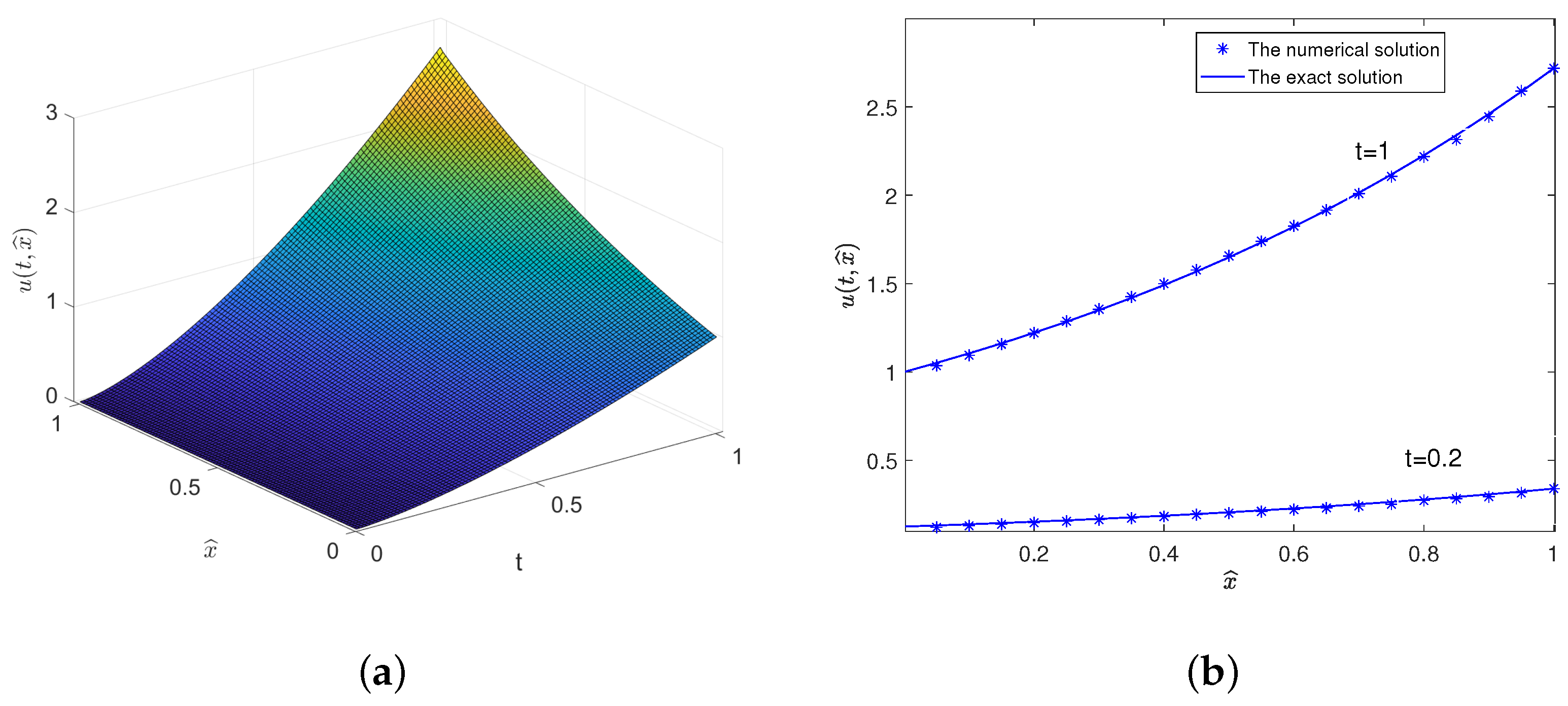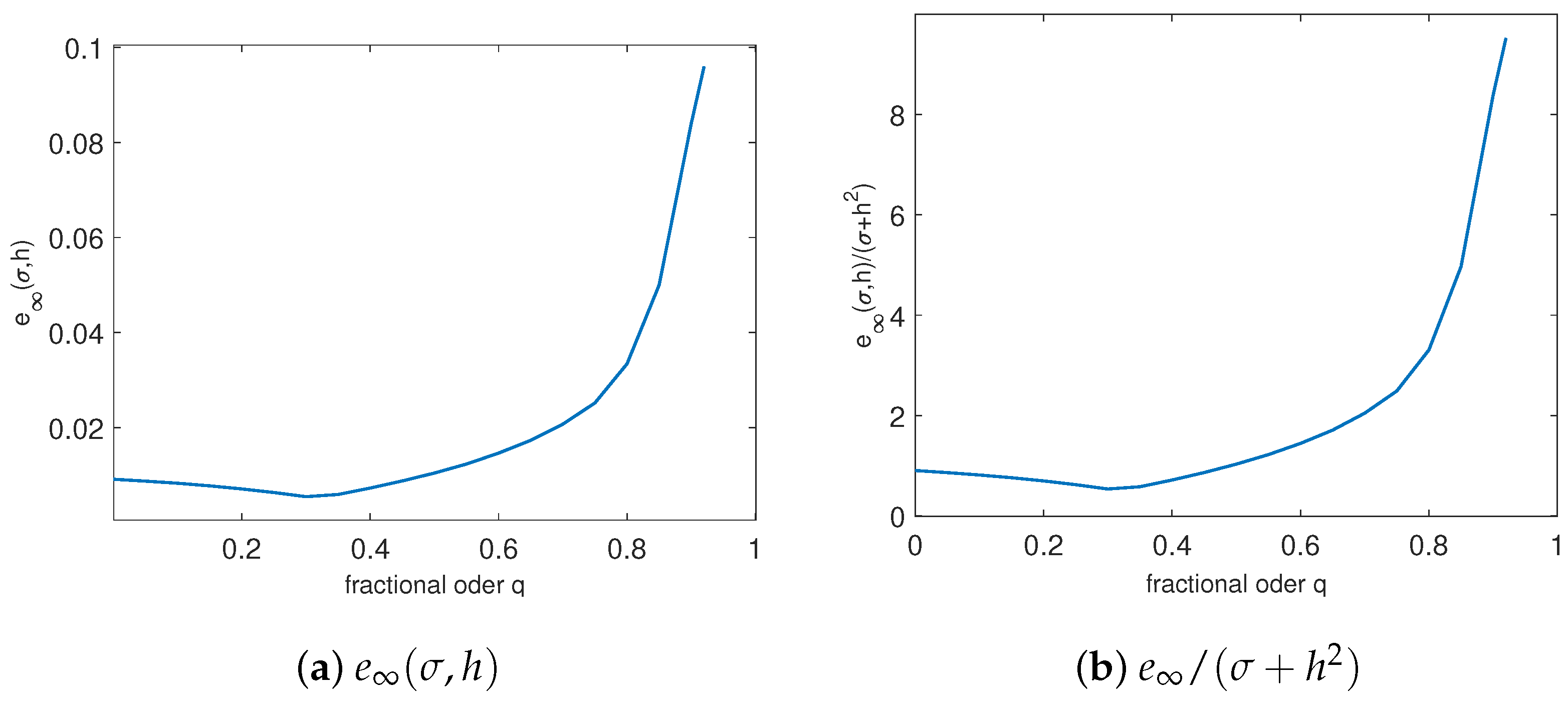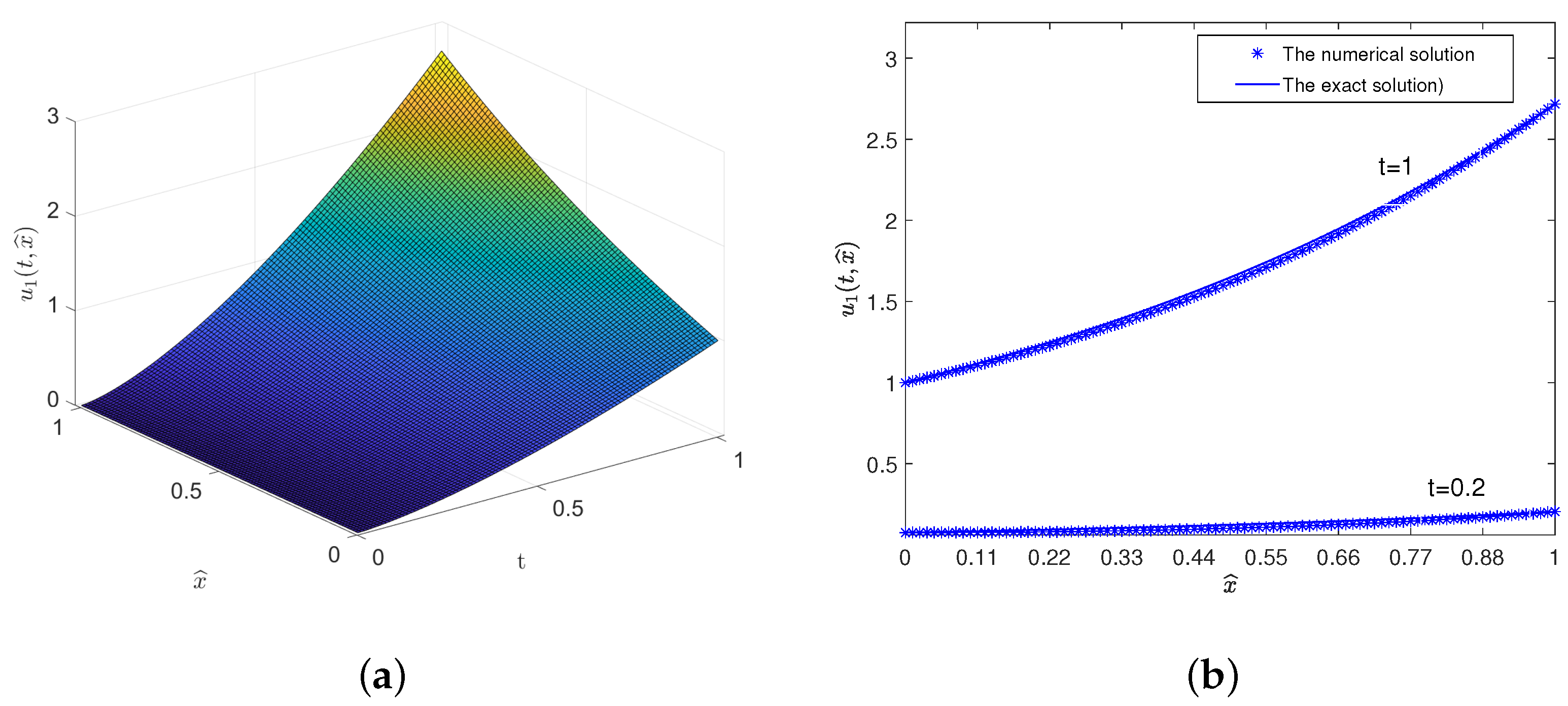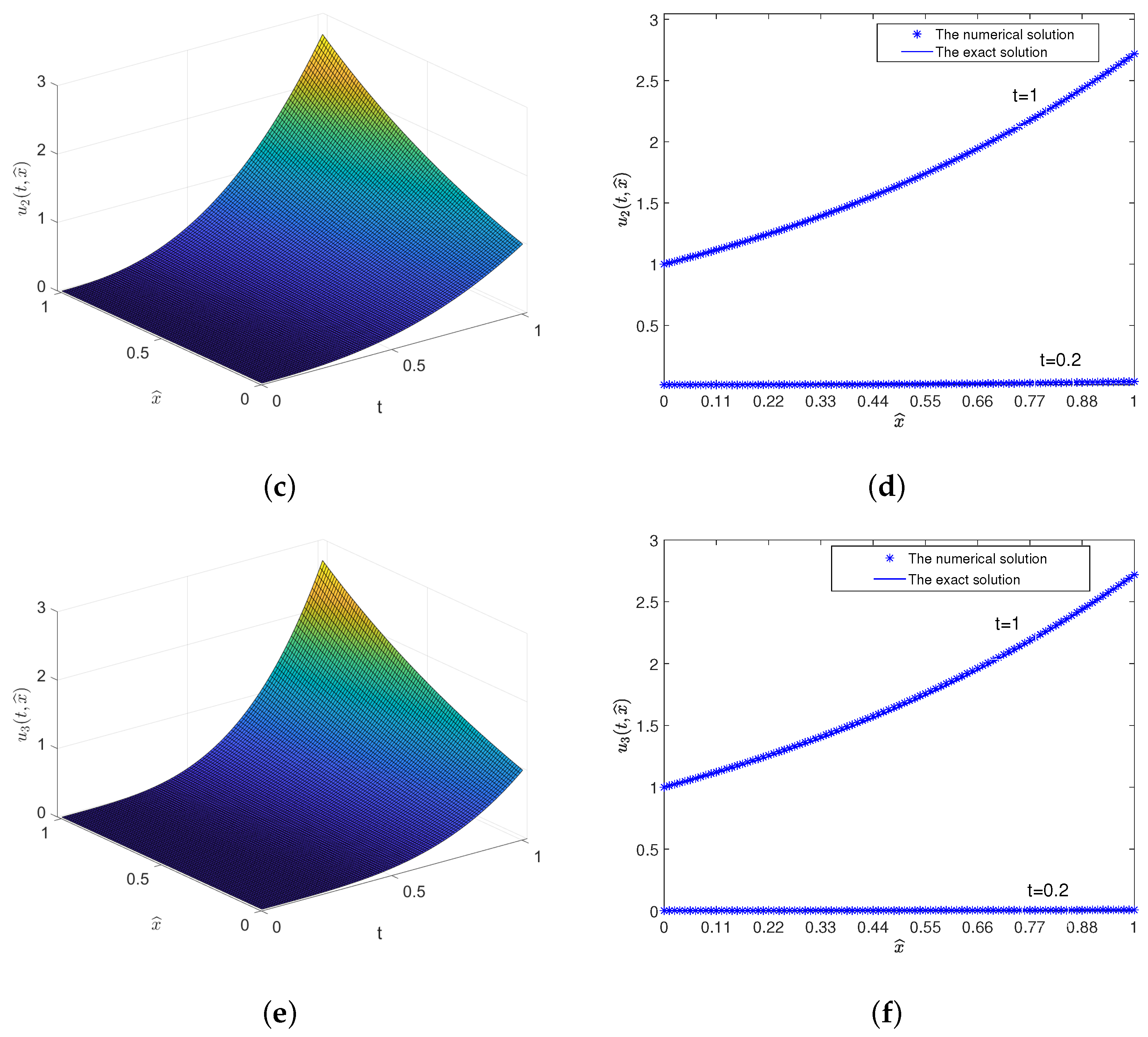1. Introduction
Reaction–diffusion equations are commonly used in natural sciences as mathematical models for systems that combine reactions and diffusive motion [
1,
2,
3]. However, the lack of a canonical model for reactions between chemically interacting species that move by anomalous subdiffusion makes it challenging to model such systems in the natural sciences. The type of mesoscopic equation that describes reaction subdiffusion depends on assumptions concerning the microscopic behavior of individual molecules, and the relationship between mesoscopic and microscopic models is yet to be elucidated. This challenge is particularly relevant in cell biology, wherein anomalous subdiffusion is a common phenomenon. Despite these challenges, reaction–diffusion equations remain a valuable mathematical model for understanding systems that combine reactions with diffusive motion. Researchers continue to explore and refine these models to better capture the complexity of natural systems, such as inhomogeneous systems [
4], albatross flight [
5], physical scenarios [
6], and biological cells [
7,
8].
Fractional differential equations are a valuable tool for modeling practical problems in various fields [
9,
10], such as biology, chemistry, physics, medicine, and economics. They afford an advantage in that the fractional-order systems have infinite memory, taking into account information from both the current and previous states [
11,
12]. In the case of anomalous subdiffusive random walkers, the fractional diffusion equation is a better-suited continuum description than the usual diffusion equation. This allows for more accurate modeling and understanding of these systems [
13]. Several studies have suggested that the anomalous subdiffusion equation (ASub-DE) provides a more accurate description of these systems than do traditional diffusion equations [
14,
15,
16].
In recent years, the study of anomalous subdiffusion has gained significant attention, leading to the development of numerous numerical methods for solving this problem. These methods include implicit numerical method [
17,
18], finite difference [
19,
20,
21], finite element [
22,
23], and Fourier spectral methods [
24,
25]. The fractional reaction-subdiffusion equation, which describes the behavior of molecular species that react at first-order rates and move subdiffusively, was derived by Lawley [
26]. Furthermore, sophisticated techniques such as time-dependent fractional Fokker–Planck equations and stochastically switching evolution equations have been used to derive the necessary equations [
27]. Compact finite difference methods are proposed for the fractional diffusion equation and time-fractional subdiffusion equation [
28,
29,
30]. Additionally, various techniques, such as stochastic evolution equations, nonlinear perturbations, and discrete fractional Gronwall inequalities, have been used to discuss the stability, convergence, and regularity of solutions to fractional reaction–subdiffusion equations [
31,
32,
33]. These advances have significantly improved our understanding of anomalous subdiffusion and its role in various fields.
Now, a fractional-order ASub-DE [
34] is considered as follows:
A implicit numerical method for solving the fractional-order ASub-DE was proposed by Zhuang et al. [
34]. Then, a modified fractional-order ASub-DE with nonlinear source term proposed by Liu et al. [
35] can be given as
In contrast with the approach in [
34], the extended implicit difference method in [
35] is constructed using an energy method. Further, the initial boundary value problem of the fractional-order ASub-DE was examined by Zhang et al. [
36].
A Crank–Nicolson-type difference scheme was proposed for solving the fractional-order subdiffusion equation and analyzing the truncation error [
36].
Furthermore, two-dimensional time fractional-order ASub-DEs were discussed in [
37,
38,
39]. Roul and Rohil [
38] analyzed the convergence and stability of two-dimensional time fractional-order ASub-DEs based on a compact alternating direction implicit finite difference scheme. Using the high-order time-stepping scheme on graded meshes, Wei et al. [
39] analyzed a class of two-dimensional time fractional-order ASub-DEs with variable coefficients, which was considered so as to handle the weak for spatial discretization. Xie et al. [
40] applied a Galerkin finite element scheme coupled with implicit and explicit algorithm for 2D nonlinear time fractional ASub-DEs. Three-dimensional variable-order time fractional-order ASub-DEs are considered based on discrete shifted Hahn polynomials and their operational matrices [
41]. An alternating direction implicit difference method is given to solve the two-dimensional time fractional-order ASub-DEs based on discrete fractional Gronwall inequality [
42,
43]. Convergence and stability analyses of time fractional-order ASub-DEs are proposed by means of a high-order alternating direction implicit compact finite difference scheme [
44,
45].
Many natural systems, such as biological, ecological, and physical systems, are coupled systems, are composed of two or more interconnected elements that interact with each other in a complex way. In a coupled system, the behavior of each component is influenced by the behavior of the other components, leading to self-organization and emergent phenomena. Analysis of the behavior of each individual component in the system and how they interact with each other can yield deep insights into the behavior of the system as a whole. Overall, studying coupled systems is essential for understanding and effectively managing many complex natural phenomena. As regards the reaction front in an
reaction–subdiffusion process, the two coupled fractional reaction–subdiffusion equations are given as follows [
46,
47]:
where
In this paper, a system of
n-coupled fractional reaction–subdiffusion equations is proposed as
While many effective methods have been suggested for solving fractional-order ASub-DEs, there are currently few studies on the numerical analysis of
n-coupled fractional-order ASub-DEs. Therefore, it is crucial to examine both analytical techniques and numerical approaches for
n-coupled nonlinear fractional-order ASub-DEs so as to gain valuable insights into the behavior and properties of these complex systems and develop more accurate and efficient solutions for a wide range of applications.
In this paper, we present the numerical analysis and analytical techniques of
n-coupled fractional-order nonlinearity ASub-DEs. Based on the implicit numerical method in [
34,
35], we demonstrate the improvement in its application for numerical analysis of
n-coupled fractional-order nonlinearity ASub-DEs. The stability and convergence are investigated by the improved energy methods. Furthermore, three improved implicit difference methods are constructed. Two of these methods are well-suited for numerical analysis. However, one of the methods is not effective for stability and convergence analysis. In addition, the obtained conditions of stability and convergence are related to model dimension
n, highlighting the importance of temporal difference related to the model dimension. Lastly, the effectiveness of the obtained theoretical results using two numerical examples is demonstrated.
The paper is organized as follows.
Section 2 presents some preliminaries and the model description. In
Section 3, three implicit numerical methods for the
n-coupled fractional-order nonlinearity ASub-DEs are first proposed. Thereafter, the stability and convergence of the improved implicit numerical method are proposed.
Section 4 provides two computational examples to validate the given theorems. Finally,
Section 5 presents our conclusions and related discussion.
3. Main Results
In this section, improved implicit difference methods are developed for the fractional-order nonlinearity ASub-DEs. Furthermore, using the improved energy methods, the stability and convergence are discussed.
3.1. Formulation of Numerical Method
According to [
34,
35], the key approaches of implicit difference methods can be summarized in the Lemmas 1 and 2. The formulation of the improved implicit difference methods of system (
4) are given based on the Lemmas 1 and 2.
Consider a uniform grid , where N is an integer and . Additionally, . Let .
Using a discrete form of Equation (
4), we get
Based on Lemmas 1 and 2, we can get
where
,
is a constant, and
. Then, Equation (
8) becomes
According to [
34,
35], if
is a continuously differentiable function and
, we have
Hence, we obtain
.
Furthermore, when
,
where
.
From the obtained results, the following expression can be derived:
Let
, and
. Then, we have
Let total error of Equation (
12) be
. Notably,
, then
According to [
34], there exists a positive constant
such that
On the basis of the obtained expression, we have
where
.
The implicit finite difference scheme of Equation (
4) can now be derived as follows:
where
.
Let
. So, the implicit finite difference scheme can be written as follows:
Furthermore,
Equation (
15) can be rewritten in the matrix form as follows:
where
,
,
,
.
,
,
.
Remark 2. Notably, the right side of the implicit finite difference scheme equation in Equation (16) has the term . If we replace with by using similar techniques, we havewhereand . Remark 3. Due to the coupling effect of n-coupled nonlinearity anomalous subdiffusion systems, where they mutually influence and interact with each other, their stability and convergence are also interdependent. Thus, improved implicit difference methods of Equations (16) and (18) are presented to effectively addresses this issue. Our results extend the given results in [34,35] to n-coupled nonlinearity anomalous subdiffusion systems. 3.2. Stability Analysis
Theorem 1. If the discretization matrix is invertible, Equation (16) has a unique solution. Suppose that
is the approximate solution of Equation (
16) and it satisfies
Let the rounding error
. Then, it satisfies
Take
be a continuously differentiable function. Then, we have
where
is between
and
.
Upon substituting Equation (
21) in Equation (
20), we get
Define
,
, where
and
.
Let
. By multiplying Equation (
21) by
, summing over
from 1 to
, we can obtain
As a result,
Let
. Then,
If there exists
such that
for all
, the inequality
can be used to obtain
Moreover,
Notably,
and
. Therefore, we get
Hence,
Let
. Then,
Let
. Then, the following can be obtained:
Let
, if
,
The energy norm can be defined as
, where
. Hence, we have
Furthermore,
Evidently,
. Then, we get
Let
,
Let
, where
.
Let
. Then, we have
Using iterative inequality Equation (
26), we get
has the following form
where
(natural number set) is a variable coefficient, which varies with the number of iterations increases.
Theorem 2. If and , the fractional implicit numerical method is stable, which is defined by Equation (15), where Proof. If
, Equation (
26) is valid. Therefore, we only need to consider Equation (
27). We can prove the result by using the second principle of mathematical induction. If
, Equation (
26) becomes
then
where
.
Suppose that Equation (
26) holds for
, according to the assumption, we have
has the following form
where
(natural number set) is a variable coefficient.
Next, the relation must be shown to also hold for
. According to Equation (
26), we have
Let
, and we rewrite
as following:
By applying the second principle of mathematical induction, Equation (
27) is established.
We now consider the convergence property of the power series
. According to
, we have
Using this iterative formula, we have
where
.
Based on Cauchy’s theorem (also known as the root test) for power series, we have
Therefore, the convergence radius of the power series
is
. Thus, when
and
such that
In summary, we have
where
. Thus, the fractional implicit numerical method is stable, which is defined by Equation (
15). As a result, the proof is complete. □
If we use the implicit finite difference scheme of Equation (
18), we can obtain the result as follows.
Theorem 3. If , , , and , the fractional implicit numerical method is stable, which is defined by Equation (18), where Proof. Let the rounding error
. Then,
Let
. Then,
Suppose there exists
such that
for all
, and let
. Then, using
, we have
Based on Theorem 2, let
. Then, we have
Let
, and if
, we get
By defining the energy norm as
, and
, we get
If , that is, , we have .
Let
and
. Then,
The remainder of the derivation is identical to that of Theorem 2, and thus it is omitted here. As a result, the proof is complete. □
Remark 4. Upon adding the condition to Theorem 3, we can obtain results similar to those in Theorem 2. If we use similar implicit numerical method asIt can be simply calculated to obtainwhere . Let , and . Then,Applying the iterative inequality, we haveAdditionally, has the following formwhere (natural number set) is a variable coefficient, which varies with the number of iterations increases. If the number of iterations tends to infinity, a sufficient condition for the convergence of is that and are convergent series. However, when , the andThen, is not a convergent series. Therefore, the condition should be included in Theorem 3. Remark 5. Suppose the nonlinear functions are continuously differentiable functions in the deduced process. In fact, the nonlinear functions can be assumed to be Lipschitz continuous.
Remark 6. In Theorem 2, if , the stable conditions of the implicit numerical method are modified to and , where . By assuming Lipschitz continuity, we can set and , which gives the stable condition . Similarly, in Theorem 3, using Lipschitz continuity, we can set and , which gives the stable condition . In [35], the corresponding condition for the case is . Therefore, the results obtained in this paper extend the results in [35]. Remark 7. If , , and , . Therefore, the modified implicit numerical method is unconditionally stable, which is consistent with the results in [34]. Remark 8. If , , and , and setting , we can obtain the stable conditions for the implicit numerical method in Theorems 2 and 3 as .
Remark 9. The condition corresponds to the number of nonlinear equations, and this condition is reasonable. When the number of nonlinear equations is large, the stable conditions can be difficult to implement. However, the obtained condition is effective in providing a numerical method for the high-dimensional equations.
3.3. Convergence Analysis
Similarly, the convergence of the fractional-order nonlinearity ASub-DE is investigated using the energy method in this section.
According to Equation (
13), the error is
. Let
(denoted as
)
be the approximate solution of Equation (
4) at the mesh point
, which satisfies the exact solution
of Equation (
4) such that
.
Let
, denoted as
. Then, it satisfies
where
.
Suppose that
is a continuously differentiable function. Then, we have
where
is between
and
.
Substituting Equation (
35) into Equation (
34), we get
Define
,
, where
and
.
Let
. Multiplying Equation (
36) by
and summing over
from 1 to
, we have
For further calculation, we can derive
Let
. Assume that there exists
such that
for all
. Using the inequality
, we can derive
If there exists a positive constant
, we have
, then
Moreover,
Notably,
and
, we have
Let
. Then,
Similarly, let
. Then,
Let
. If
,
Define the energy norm as
Notably,
. Then, we have
Furthermore,
Evidently,
. Then, we get
Let
,
. Let
. Then, we have
According to Equation (
34), we have
and
.
In addition,
and
, there is
where
.
Using iterative inequality, we have
where
has the following form:
where
(natural number set) is a variable coefficient, which varies with the number of iterations increases.
Theorem 4. If and , the fractional implicit numerical method is convergent, which is defined by Equation (15), where Proof. If
, Equation (
40) is valid. Hence, we only need to consider Equation (
41). We can prove the result based on the second principle of mathematical induction. If
, Equation (
41) becomes
then
where
.
Suppose that Equation (
41) holds for
; according to the assumption, we have
has the following form
where
(natural number set) is a variable coefficient.
Next, we prove that the relation is also true for
. According to Equation (
42) and
, we have
Let
. We can write
in the following polynomial form
Thus, we get
By the second principle of mathematical induction, Equation (
41) is established.
Notably,
. Then,
Similarly, according to
, we have
Using this iterative formula, we have
where
.
Based on Cauchy theorem (the root test) of power series, we have
Therefore, the convergence radius of the power series
is
.
When
, there
such that
Additionally, we have
where
.
As a result, the fractional implicit numerical method is convergent, which is defined by Equation (
15). The proof is complete. □
Upon using the implicit finite difference scheme of Equation (
18), we obtain the following result.
Theorem 5. If , , , and , the fractional implicit numerical method is convergent, which is defined by Equation (18), where Proof. Let
, denoted as
, which satisfies
where
. Similarly, define
where
and
.
Let
. Multiplying Equation (
44) by
and summing over
from 1 to
, we obtain
Assume there exists
such that
for all
. Using
, we have
Based on the proof of Theorem 4, let
. Then, we have
Let
, and we have
. Additionally, if
, we get
Define the energy norm as
If
, that is,
, we have
. Let
,
, and
. Then, we get
where
and
.
In addition,
and
; using iterative inequality, we have
where
.
The remainder of the derivation is identical to that of Theorem 4. Hence, it is omitted here. The proof is complete. □
4. Numerical Analysis
In this section, we present two examples of numerical simulation using MATLAB R2021a to illustrate the theoretical results of the paper.
The maximum norm error between the exact solution and the numerical solution is defined as follows:
Define the convergence orders in the temporal direction by [
49]
and in the spatial direction by
respectively.
Example 1. A fractional-order nonlinearity ASub-DE with is given as followsThe exact solution of the system (47) is . The initial values are , , and . The nonlinearity reaction–diffusion system parameters of (47) are chosen as , , , and , and they satisfy the conditions in Theorems 2 and 4. In addition, let , and . The simulation results of system (47) with and are given in Figure 1. When fractional order , the behaviors of the solution and its derivatives of the system (47) are shown in Figure 1a. The exact solution and numerical solution are compared in
Figure 1b for
and 1, respectively.
Figure 1b shows that the numerical solution is in good agreement with the exact solution. Consider the exact solution
and numerical solution
obtained by the implicit difference method.
The maximum-norm error
, temporal, and spatial convergence orders for these finite difference schemes are listed in
Table 1. It is clear to see that the computational convergence orders are close to theoretical convergence orders; i.e., the convergence orders of the finite difference scheme Equation (
18) in the temporal direction are both nearly first order and in the spatial direction are nearly second order.
Next, we focus on the impacts of fractional-order
q on the numerical solution of the equation. Choose the difference scheme as
, the fractional-order
.
and
are varying with the fractional-order
q, which are given in
Figure 2. From the
Figure 2a, the
increases with the increase of
q on the whole. But the increase is not very significant, as shown in
Figure 2a. However, when the
q increases, the
increases. Especially, when
, the
significantly increases.
According to the Riemann–Liouville fractional derivative,
when the fractional-order
, differences will generate singularity, so the
significantly increases. Similarly, from the
Figure 2b, the
increases with the increase of
q on the whole. But the increase is not very significant, as shown in
Figure 2b. However, when the
q increases, the
increases. Especially, when
, the
significantly increases.
Example 2. A fractional-order nonlinearity ASub-DE with is given as follows:The exact solution of the system (48) is , and . Then, the initial values , , , , , , , , . The nonlinearity reaction–diffusion system parameters of system (47) are chosen as , , , , , , , , , , , , , , , and . Additionally, they satisfy the conditions in Theorems 2 and 4. We select , , and ; then, they are continuously differentiable functions or Lipschitz continuous. We take the control input vector as , , . The simulation results of system (48) with , are shown in Figure 2. When fractional order , the behaviors of the solution and its derivatives of the system (48) are shown in Figure 3 a,c,e. The comparison results of the exact solution and numerical solution are shown in
Figure 3 b,d,f, when
and 1, respectively.
Figure 2 shows that the numerical solutions are in good agreement with the exact solutions. We take the exact solution
and numerical solution
obtained by the implicit difference method.
The maximum-norm error
, temporal, and spatial convergence orders for these finite difference schemes are listed in
Table 2. It is clear to see that the computational convergence orders are close to theoretical convergence orders; i.e., the convergence orders of the finite difference scheme Equation (
18) in the temporal direction are both nearly first order and in the spatial direction are nearly second order.
Remark 10. From the Table 2, due to the coupling effect of n-coupled nonlinearity anomalous subdiffusion systems, error components interact and cause certain deviations. It should be noted that the convergence order achieved by the proposed method is not exceptionally high; nevertheless, it establishes a implicit difference methods for solving n-coupled nonlinearity anomalous subdiffusion systems. Developing algorithms yielding more accurate numerical solutions with higher-order convergence will be focused on in future work. 5. Conclusions and Discussion
This paper presents an investigation on the numerical analysis and analytical technique of n-dimensional fractional-order nonlinearity ASub-DEs. We propose some improved implicit difference methods and discuss the stability and convergence using the improved energy methods. The stability and convergence conditions are given based on different implicit methods and related to the system dimension n. Finally, we provide two numerical examples to validate the effectiveness of our theoretical results.
There are some potential research directions that can be considered for future work. The nonlinearity term of
n-dimensional fractional-order nonlinearity ASub-DEs is beyond the scope of this study. The numerical analysis of the
n-dimensional fractional-order nonlinearity ASub-DEs, which have the following form, will be considered in future work:
Based on the relations between the Riemann–Liouville and Caputo definitions, we have
Furthermore, the maximum norm error estimate may not be sufficiently small. Therefore, constructing a high-accuracy difference scheme in the future work for solving n-dimensional fractional-order nonlinearity ASub-DEs would have both theoretical and practical significance. In addition, time delay is a well-known factor that can cause oscillations or instabilities in dynamic systems, and it can affect the stability and of the systems. Therefore, the numerical analysis of n-dimensional fractional-order nonlinearity ASub-DEs with time delay would be an interesting and challenging topic for future research.











